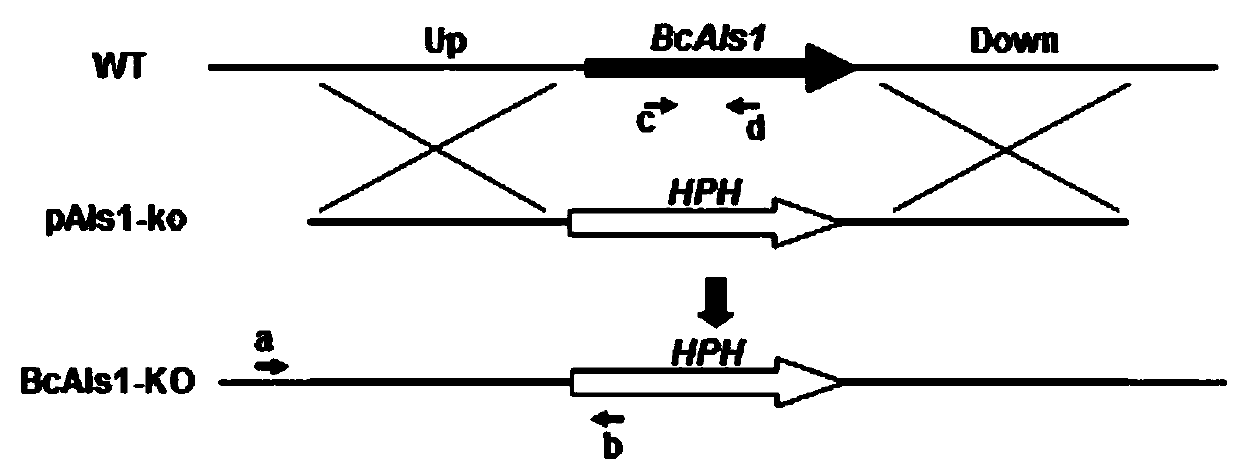A Botrytis cinerea gene bcals1 related to pathogenicity and its application
A technology of Botrytis cinerea and Botrytis cinerea, applied in the application field of genes and their encoded proteins, can solve the problems of little known molecular mechanisms
- Summary
- Abstract
- Description
- Claims
- Application Information
AI Technical Summary
Problems solved by technology
Method used
Image
Examples
Embodiment 1
[0023] Example 1 Correlation analysis of BcAls1 gene
[0024] The open reading frame of the BcAls1 gene of Botrytis cinerea consists of 1918 nucleotides, including 2 exons, the full-length cDNA of the coding region is 1851 nucleotides, and the encoded protein product consists of 616 amino acids. The BcAls1 protein sequence was compared and analyzed (http: / / blast.ncbi.nlm.nih.gov / Blast.cgi), and it was found that Als1 widely exists in cellular organisms such as animals, plants, fungi and bacteria. Domain analysis revealed that the BcAls1 protein contains a conserved aminolevulinic acid synthase domain (see figure 1 ).
Embodiment 2
[0025] Example 2 Knockout of BcAls1 gene
[0026] 1) Construction of knockout vector
[0027] Using primers Als1-UP-F (5'-GAATTCATGGTGCTCGTATCGTTTGA-3') and Als1-UP-R (5'-GGTACCGCGGGATGATGGATTATTATGT-3') to amplify the upstream of the BcAls1 gene using the genomic DNA of Botrytis cinerea strain B05.10 as a template 603bp fragment, using Als1-DN-F (5'-GGATCCTCCTCGGACCCAATACCAC-3') and Als1-DN-R (5'-AAGCTTCTTTAAGCGAGGTCACGGA-3') to amplify the downstream 911bp fragment of Botrytis cinerea BcAls1 gene, the reaction system is: 10mmol / L dNTP Mixture, 0.5 μL; 10×PCR buffer, 2.5 μL; each 1 μL of upstream and downstream primers (10 μmol / mL); template DNA, 1 μL; Ex-Taq, 0.2 μL (5U); ddH 2 O, 18.8 μL; amplification program: 94°C pre-denaturation for 3 minutes, then (1) 94°C, denaturation for 50 seconds; (2) 58°C, annealing for 50 seconds; (3) 72°C, extension for 60 seconds; (4) ) cycled 30 times; (5) extended at 72°C for 10 minutes. The above two DNA amplification products were succ...
Embodiment 3
[0037] Example 3 Genetic Complementation of BcAls1 Gene Deletion Mutants
[0038] Primers C-F (5'-GTCGACTGATGGGAAACCCTGGATG-3') and C-R (5'-GTCGACCTTTAAGCGAGGTCACGGA-3') were used to amplify the full-length 3875bp gene of Botrytis cinerea BcAls1 (including promoter, open reading frame and terminator), and cloned into pMD18-t vector, and then subcloned into the SalI site of pSULF vector (containing chlorimuron-methyl resistance gene), and constructed into genetic complementation vector pAls1-ko-c. The vector was verified by sequencing to confirm that there were no amino acid mutations. Using the Agrobacterium-mediated transformation method as described above, 100 μg / mL chlorimuron-methyl was used for screening, and the complementary fragment was transferred into the genome of the BcAls1 gene deletion mutant M1 to obtain a genetically complementary strain M1 / Als1. The primers a and b, c and d used in the mutant verification were selected for PCR amplification, and the results w...
PUM
 Login to View More
Login to View More Abstract
Description
Claims
Application Information
 Login to View More
Login to View More - R&D
- Intellectual Property
- Life Sciences
- Materials
- Tech Scout
- Unparalleled Data Quality
- Higher Quality Content
- 60% Fewer Hallucinations
Browse by: Latest US Patents, China's latest patents, Technical Efficacy Thesaurus, Application Domain, Technology Topic, Popular Technical Reports.
© 2025 PatSnap. All rights reserved.Legal|Privacy policy|Modern Slavery Act Transparency Statement|Sitemap|About US| Contact US: help@patsnap.com



